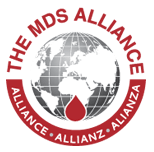Any ideas ? Similar experience ?
Home Demo › forums › Patient Message Board › Any ideas ? Similar experience ?
Tagged: Iron Chelation, Lucpatercept, MDS
- This topic has 0 replies, 1 voice, and was last updated 7 years, 3 months ago by
constantineadraktas.
-
AuthorPosts
-
January 2, 2017 at 6:09 pm #31491
constantineadraktas
ParticipantA retrospective view of my MDS on the basis of my keeping diligent records of every step in its evolution and having read almost every peer medical paper on it
A. Key issues as of 1 January 2017
My MDS further evolution should be placed, among other things, in the context of the following two immensely important parameters.
1. I am now EPO Refractory and I am transfused twice a month and a huge threat hangs over me, as it is questionable whether or not Exjade will be able to remove from my body the past huge amount of Iron accumulated since March 2013 in addition to removing transfusional Iron intake from the current transfusions.
2. Celgene is redirecting the MEDALIST trials to Low risk MDS with above 15% Ring Sideroblasts ( my case ) and the Luspatercept appearance will be delayed to 2020, that is when I will be 80 years old and a lot of things can happen until then. My mother made it to 97.
B. My MDS medical history
I was diagnosed with RCUD RA MDS ( it was RCMD RS ) in early March 2013.
However, had I known about the New Generation Sequencing ( NGS ) mutation tests at the time I would have seen that I belong to a distinct subset of MDS, namely, the SF3B1 mutated MDS with over 15% Ring Sideroblasts subset ( paper by Luca Malcovati, Elli Papaemmanuil, Eva Hellstrom – Lindberg and others ).
My parameters preceding the above diagnosis and my most recent ones are shown and compared in the following table.Dates Hemoglobin Hematocrit Ferritin Creatinine ESR
21 January 2013 9.0 26.3 645 1.34 30
26 February 2013 8.5 25.9 NA NA NA
30 December 2016 8.4 25.0 3636 2.39 51Hemoglobin is a more reliable measurement than Hematocrit.
I was placed immediately on Blood Transfusions but as I found out much later, Blood Transfusions down regulate hematopoiesis and subsequently down regulate the immune response.
I was placed on NeoRecormon 30000 Hematopoietic injections in early May 2013, which started increasing the time gaps between my Blood Transfusions.
Considering the down regulating effects of Blood Transfusions, it appears that I should have been placed on Hematopoietic injections in early May 2013 and not on Blood Transfusions.
At the same time, I should have been placed on mild Iron Chelation and have kept my Ferritin at under 500 or at worse at 1000, for the following reasons.
1. Ferritin impedes Erythropoiesis
2. Most patients on Iron Chelation have no symptoms or signs of Heart failure
3. For every Ferritin 500 points above 1000 the death risk increases by a factor of 1.36
At my current level of 4000, my death risk is just over 8 fold as compared to my death risk if my Ferritin had been kept at the 1000 level.
4. Low Risk MDS patients with Ferritin under 500 survive for under 10 years.
That would have given me an extra 6 years
4. For Ferritin below 500 the Leukemia free survival is much longer
In the summer of 2014 I discovered that I am Copper Deficient and that the symptoms of this condition mimic the MDS symptoms.
The matter was passed without further investigations, despite the fact that Copper is a significant player in Iron Metabolism.
In August 2014, Eprex 40000 injections replaced the NeoRecormon 30000 injections ( as there is no NeoRecormon 40000 ) and Lenograstim 105 ( G CSF ) injections were added.
The time gaps between my NeoRecormon 60000 moved up exponentially and reached a peak of 283 days in July 2015, 26 months after the initiation of my Hematopoietic injections ( median for Low Risk MDS – Eva Hellstrom – Lindberg and others ).
At that point my Hemoglobin moved to a lower level and the Eprex 40000 ceased to have any effect on my Erythropoiesis.
Ferritin was at the 1900 level.
That I became, starting July 2015, EPO Refractory was not recognised until 7 months later, after one further Blood Transfusion and my surviving at a lower Hemoglobin level.
Ferritin was at the 2500 level ( no Iron Chelation program prescribed before ).
A high multifaceted penalty, as I should have been moved to NeoRecormon 60000 ( 2 * NeoRecormon 30000 ) by August 2015 and, thus, stay longer away from frequent Blood Transfusions.
The 2 * NeoRecormon 60000 regime will start now, very early 2017, after several Blood Transfusions since I become EPO Refractory.
Iron Chelation, via Exjade, did not start until April 2016, when my Ferritin was at the 2785 level and my Liver Fe was 15.1 ( being 8 in October 2014 – Perfusion test for my Heart in London – I was not prescribed Liver Fe MRI tests in Athens until Iron Chelation came into the game ).
Now, my last Ferritin measurement taken on 30 December 2016 is 3636, plus 851 on 2785, and my Liver Fe is down to 12.9 having reached 16 in June 2016 when Ferritin was 2900.
Exjade is unloading Iron from Liver etc into the Blood stream and, for the time being, is helping Blood Transfusions in pushing Ferritin up. -
AuthorPosts
Register for an account, or login to post to our message boards. Click here.
- You must be logged in to reply to this topic.









